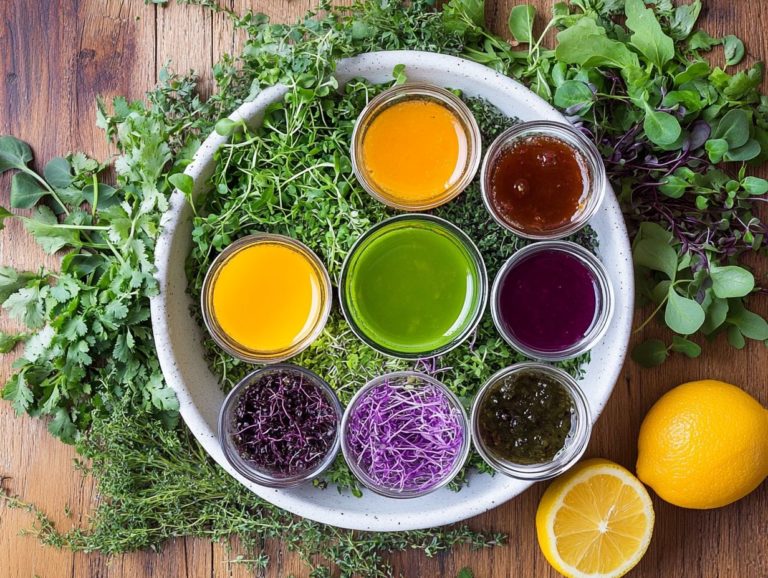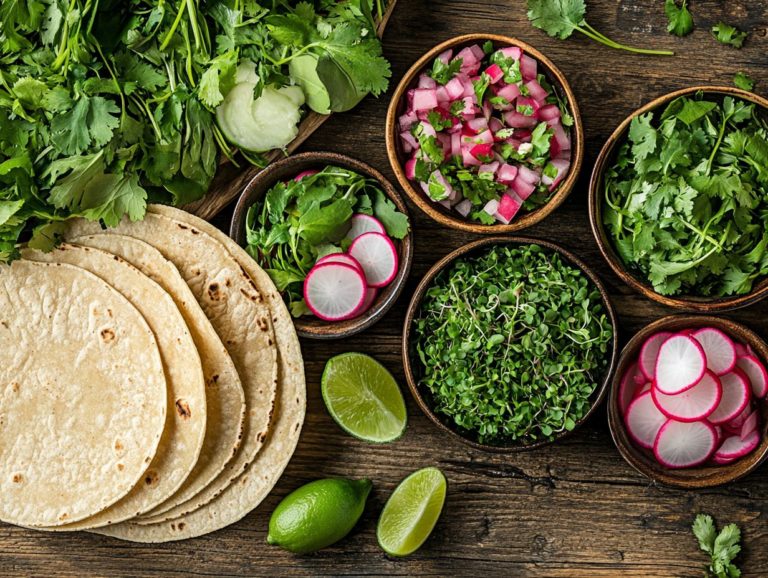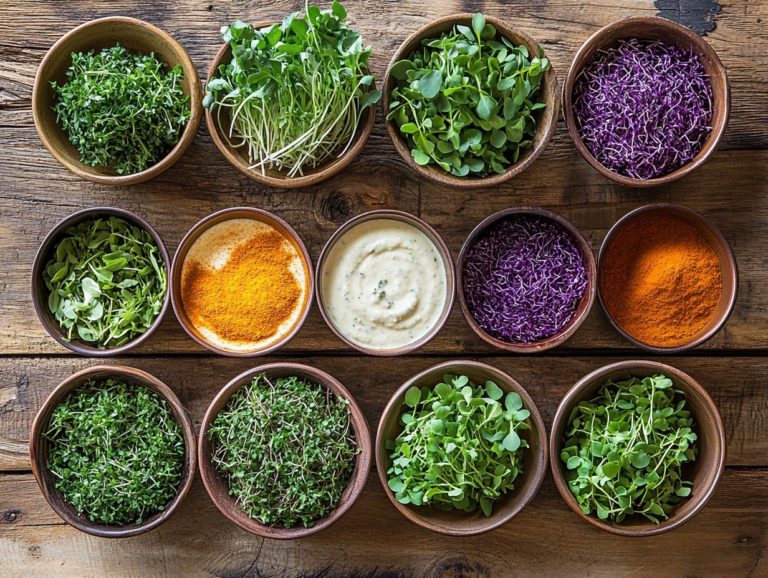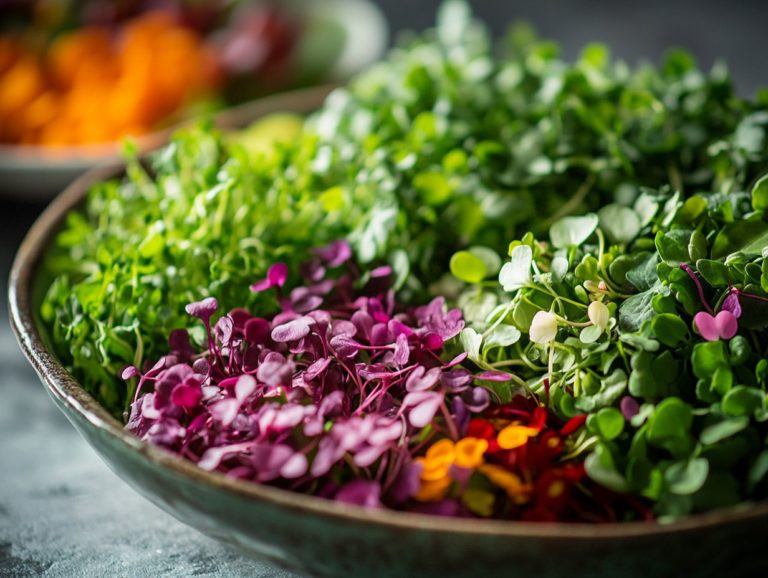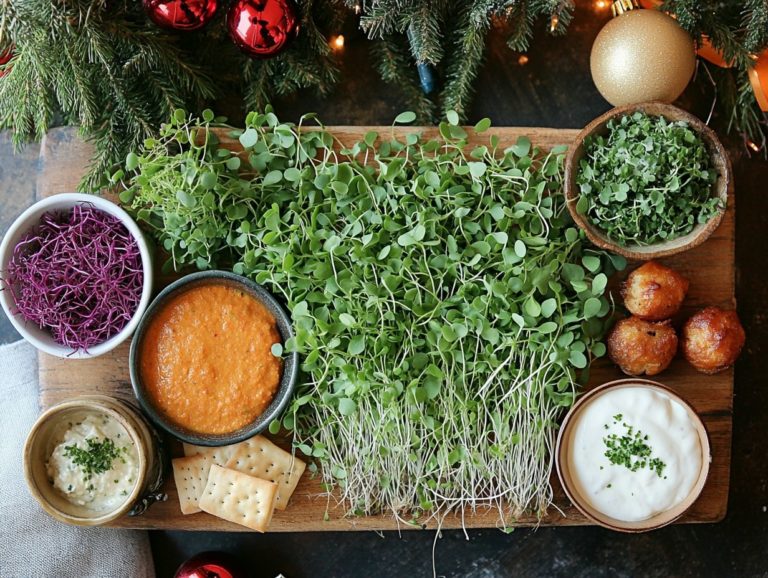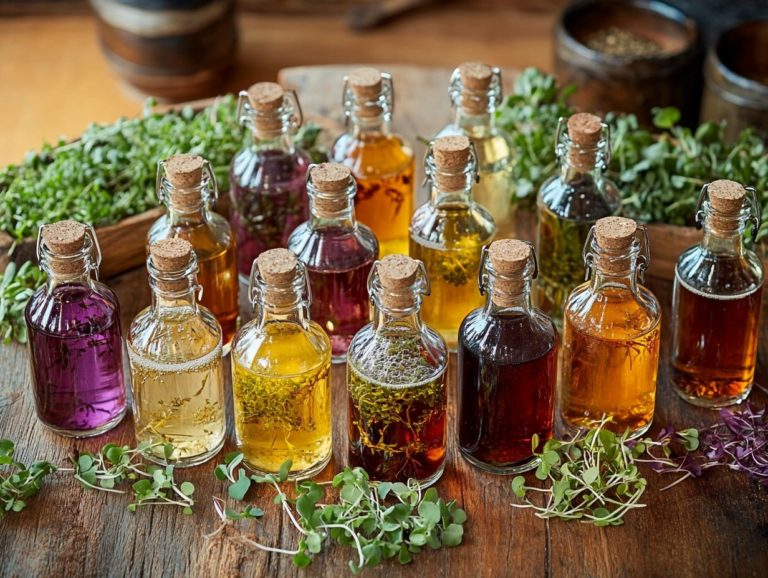47. How to Add Microgreens to Your Desserts
Microgreens are not just tiny, flavorful greens; they are plants packed with nutrients that can elevate your dishes far beyond traditional salads.
Dive into the captivating world of microgreens. Understand what they are, uncover their remarkable nutritional benefits, and discover how they can enhance your desserts with microgreens.
Explore various types of microgreens that add distinctive flavors to sweet treats, including strong-flavored varieties. You’ll find inventive recipes and practical growing tips.
You will also gain insights into essential food safety considerations, especially regarding allergy concerns.
Get ready to wow your guests with incredible dessert transformations!
Contents
- Key Takeaways:
- What are Microgreens?
- Definition and Nutritional Value
- Benefits of Adding Microgreens to Desserts
- Types of Microgreens to Use in Desserts
- How to Incorporate Microgreens into Dessert Recipes
- Tips for Growing Your Own Microgreens
- Potential Risks and Precautions
- Frequently Asked Questions
- 1. What are microgreens and why should I add them to my desserts?
- 2. How do I incorporate microgreens into my dessert recipes?
- 3. Which types of microgreens work best in desserts?
- 4. Can I grow my own microgreens for desserts?
- 5. Can I safely enjoy microgreens in my desserts?
- 6. What are the health benefits of adding microgreens to desserts?
Key Takeaways:
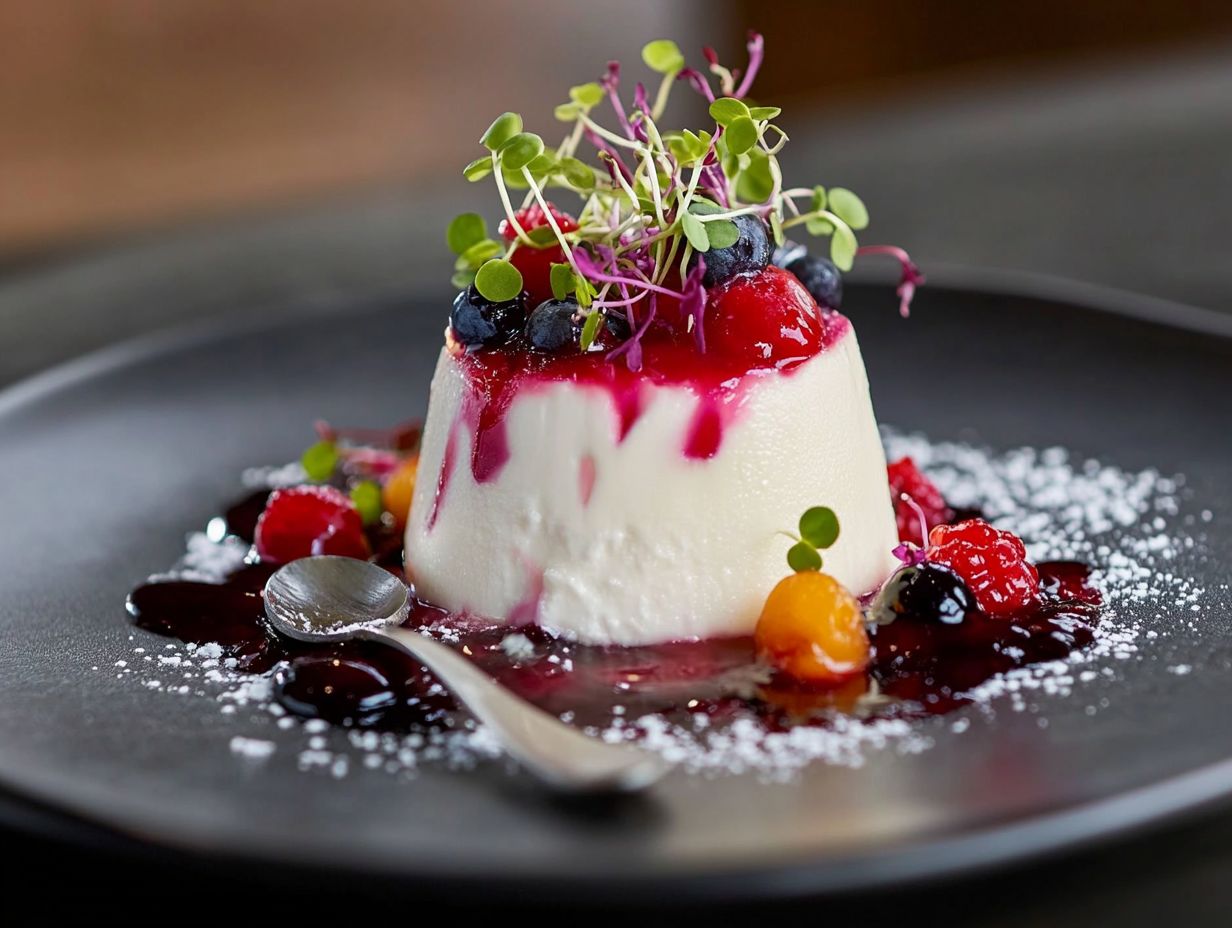
- Microgreens are nutrient-dense baby plants that can be added to desserts for a boost of flavor and health benefits.
- By incorporating microgreens into desserts, you can enhance the taste and nutritional value of your sweet treats.
- Some popular microgreens to use in desserts are chives, spinach, and radish microgreens. Be creative and experiment with different flavors!
What are Microgreens?
Microgreens are exquisite, edible plants harvested just after their first true leaves emerge. They shine with vibrant colors and boast intense flavors, making them a delightful addition to your culinary repertoire. With a wide variety of species to choose from think chives, spinach, and various salad types these tiny greens offer remarkable versatility for your meals.
Not only are they visually striking, but microgreens also provide an impressive boost of vitamins and minerals. In the kitchen, they elevate your dishes in innovative ways, whether as standout ingredients or elegant garnishes gracing the plates of cooking shows and upscale restaurant menus.
Embracing microgreens in your cooking can transform the ordinary into the extraordinary.
Definition and Nutritional Value
Microgreens, often called ‘baby greens,’ are the young seedlings of edible vegetables and herbs. They are celebrated for their remarkable nutritional profiles.
These tiny powerhouses are loaded with vitamins, including C, E, and K, along with essential minerals like magnesium, potassium, and iron. They are also rich in antioxidants, which help shield your body from oxidative stress that is, damage to your cells and inflammation. Remarkably, compared to their fully grown counterparts, microgreens can deliver up to 40 times more vital nutrients per ounce, making them a fantastic choice for salads and healthy snacks.
Their vibrant flavors and textures elevate your dishes while providing an effortless way to enhance your overall nutrition without piling on significant calories, especially when used in pesto sauces.
Benefits of Adding Microgreens to Desserts
Incorporating microgreens into desserts is an innovative culinary trend that elevates flavor while enhancing nutrient retention. This transforms sweet treats into healthier and more captivating creations.
By harnessing the bold tastes of varieties like spicy or sweet microgreens, you can turn traditional desserts into gourmet experiences. Whether you use them as elegant toppings for cakes or blend them into pestos for unique flavor profiles, these petite greens provide a creative edge that redefines dessert recipes. To learn more, check out this guide on How to Incorporate Microgreens into Your Diet.
Enhancing Flavor and Nutrient Density
Incorporating microgreens into your desserts can elevate both flavor and nutrient density, adding a unique twist to your traditional sweet dishes.
These tiny greens are packed with concentrated nutrients and offer a range of tastes from peppery to sweet, allowing for endless creativity in your culinary endeavors. For example, adding radish microgreens to a chocolate mousse introduces a delightful heat that beautifully contrasts with the rich cocoa. Similarly, the refreshing notes of basil microgreens can transform a fruit tart, creating a more complex and exciting taste experience.
But don t stop at desserts; these versatile greens truly shine in savory dishes as well. Imagine adding a burst of flavor and a nutrient boost to your guacamole or fresh salsas. With their adaptability, microgreens can enhance your meals while showcasing their impressive health benefits across various culinary settings.
Ready to elevate your dishes? Try adding microgreens to your desserts today!
Types of Microgreens to Use in Desserts
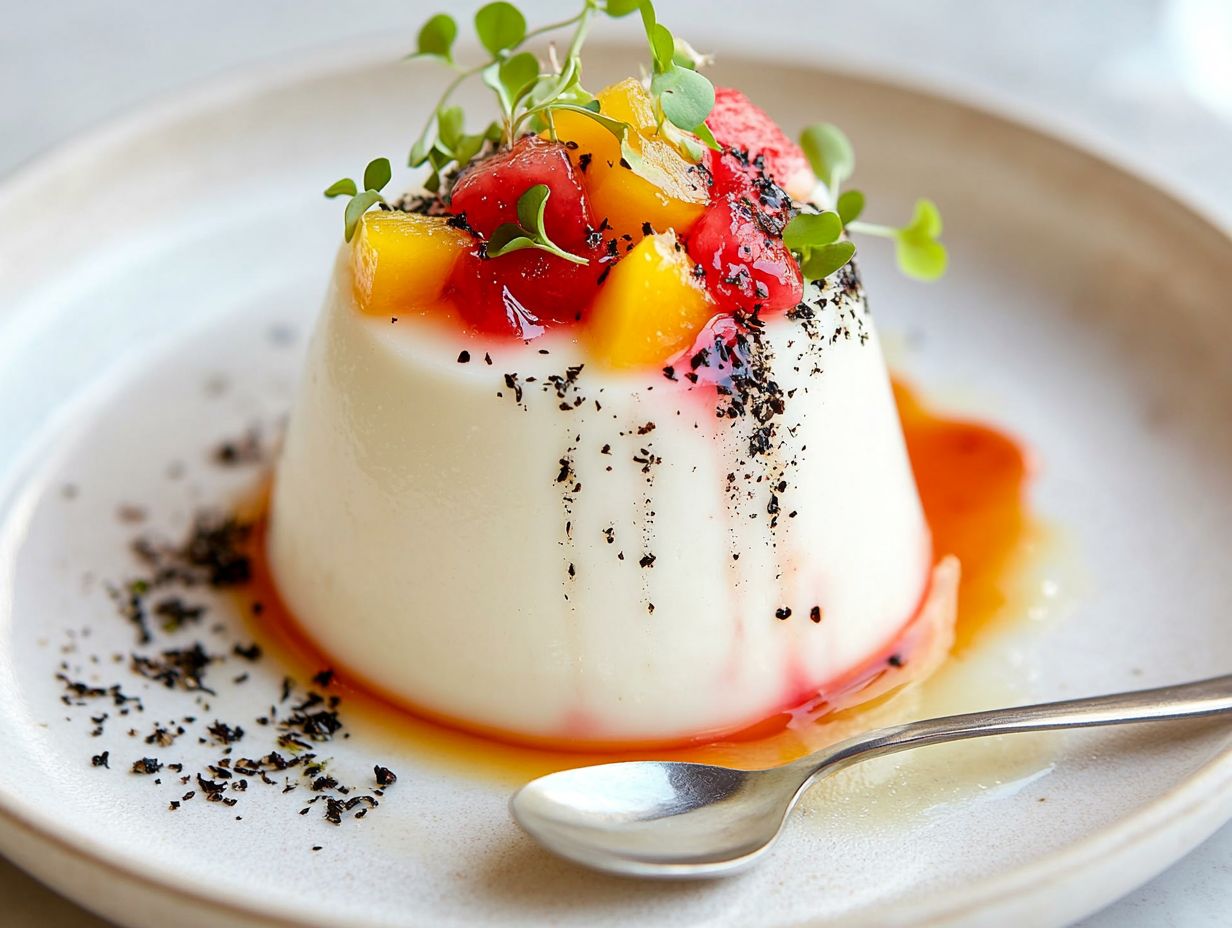
Selecting the perfect microgreens for desserts opens up a world of flavorful possibilities, each one offering its own distinct taste and visual charm.
Consider popular options like sweet basil and beet greens to elevate your fruit-based desserts. They bring a fresh twist to their natural sweetness. For those daring enough, spicy microgreens like mustard greens can add a surprising yet tasty flavor to chocolate dishes.
Understanding the nuances of these microgreens will transform your ordinary desserts into unforgettable culinary delights.
Popular Varieties and Their Flavors
There are several popular varieties of microgreens you can explore to elevate your desserts. Each boasts its own distinct flavor profile.
Take radish microgreens, for instance; their peppery bite creates a delightful contrast when sprinkled atop creamy panna cotta or added to fruit tarts.
Then there s basil microgreens, which infuse a sweet, aromatic essence. This is perfect for elevating chocolate mousses or serving as a fragrant garnish for gelato.
Don t overlook beet microgreens either. These bring an earthy sweetness that complements and enhances the visual appeal of desserts like berry compotes or cakes.
When you creatively integrate these microgreens into your recipes, you introduce unique flavors and vibrant colors. This transforms your desserts into both aesthetic delights and indulgent treats.
How to Incorporate Microgreens into Dessert Recipes
Incorporating microgreens into your dessert recipes unveils a realm of creative and delicious possibilities. You can experiment with flavors and presentations like never before.
Imagine using them as a stunning garnish on cakes or blending them into smoothies and chilled soups. Microgreens not only enhance the visual appeal but also provide a nutritional boost to a variety of desserts.
This versatility makes them an exciting ingredient that can elevate classic recipes into contemporary delicious dishes.
Creative and Delicious Ideas
You ll discover countless ways to incorporate microgreens into your desserts. They not only add flavor but also a striking visual appeal.
These vibrant little greens have the power to transform a simple dish into a culinary delight. For example, imagine adding a handful of peppery arugula microgreens to a rich chocolate cake; it creates a delightful burst of flavor that beautifully complements the sweetness.
You can blend beet microgreens into a berry smoothie. This not only enhances the drink s nutritional profile but also introduces a unique, earthy twist.
Incorporating microgreens into dessert sauces like a tangy lime glaze can elevate the entire experience. Each bite becomes not just delicious but also stunningly beautiful. Embracing these ingredients delights the palate and adds sophistication to any sweet treat.
Tips for Growing Your Own Microgreens
Growing your own microgreens is a rewarding and cost-effective endeavor. It allows you to enjoy fresh, nutritious greens from the comfort of your home, elevating both your culinary creations and healthy snacks.
With just a small amount of space and minimal equipment, you can effortlessly cultivate a variety of microgreens like radish, kale, or chives right on your windowsill or countertop. This approach gives you easy access and a thrilling way to enjoy fresh greens at home!
Don’t wait! Start growing your own microgreens today and nurture a deeper connection to the food you prepare. This enhances your overall cooking experience.
Simple and Affordable Ways to Grow Microgreens
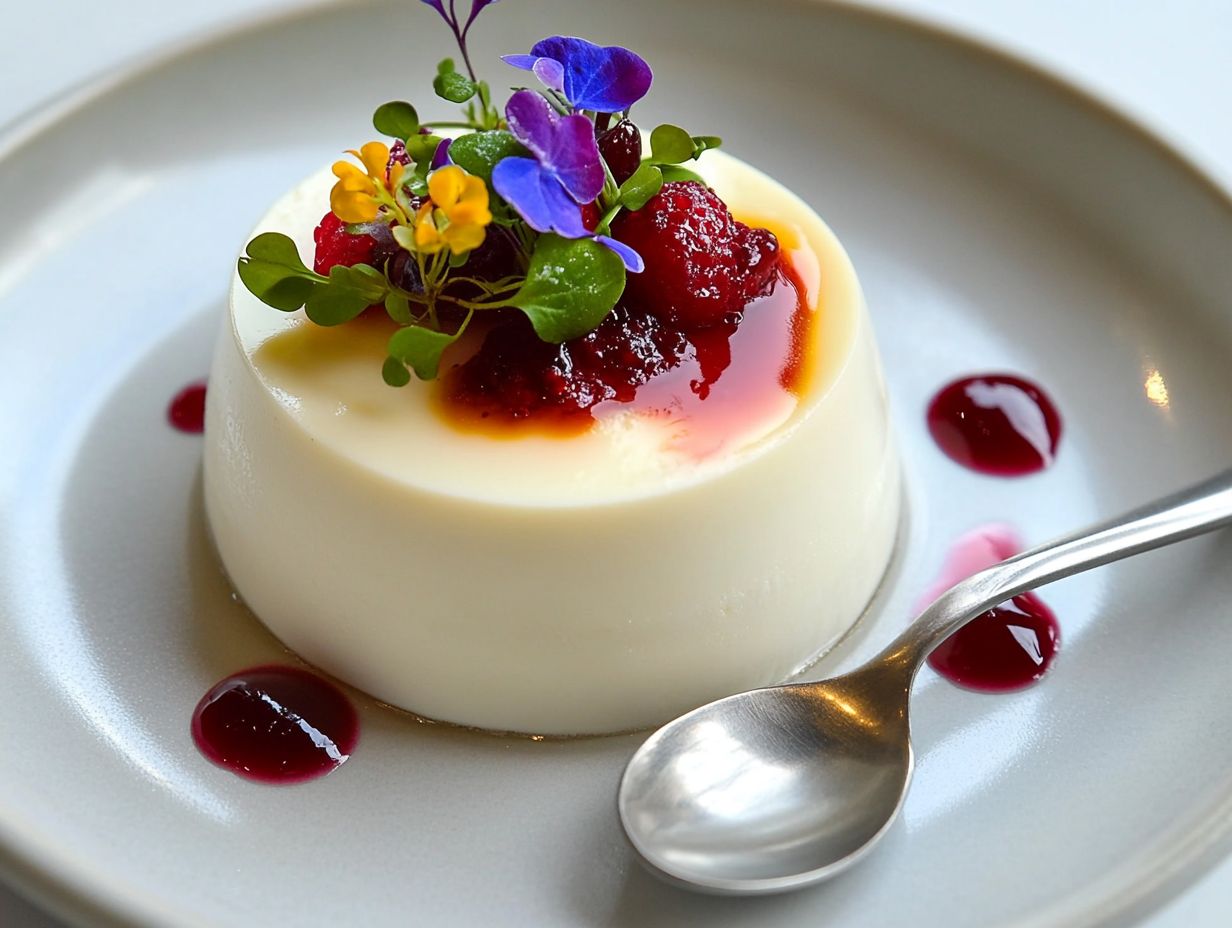
You ll find several easy and cost-effective methods for growing microgreens that require minimal investment and space.
From soil-based options to innovative hydroponics growing plants without soil using nutrient-rich water or even repurposed containers like old takeout boxes, you can easily dive into the joys of home gardening. By using simple techniques like placing seeds in rich potting soil and ensuring they receive ample light, you ll love how enjoyable and rewarding the process is!
Not only will cultivating these vibrant greens save you money on groceries, but you ll also experience the satisfaction of harvesting fresh, healthy produce right from your kitchen. With just a little time and care, you can transform any small area into a flourishing garden, making it accessible to anyone looking to embrace the green-thumb lifestyle.
Potential Risks and Precautions
While microgreens offer many health benefits, it s crucial to remain aware of potential risks and necessary precautions. This diligence helps ensure food safety and addresses any allergy concerns.
Food Safety and Allergy Concerns
Food safety and allergy concerns are paramount when consuming microgreens, especially since some individuals may have sensitivities to specific varieties, including strong-flavored types like spicy microgreens.
To ensure a safe experience, adopt proper washing and storage practices for these delicate greens. Rinse your microgreens thoroughly under cold water to eliminate dirt, contaminants, and potential pesticides. You can add them to cold soups for a refreshing twist.
After washing, dry them gently with a salad spinner or a clean kitchen towel to avoid excess moisture that can lead to spoilage. Store the washed microgreens in a pristine, airtight container in the refrigerator, keeping the temperature below 40 F. They also make great pizza toppings or additions to guacamole for extra flavor.
It’s vital to educate yourself about common allergens linked to certain microgreen types and consult with a healthcare provider if you have existing food allergies. Vigilance is key to promoting safe consumption and enjoyment of these nutritious superfoods, which can also be featured in cooking shows, like a recent episode of a microgreens podcast.
Frequently Asked Questions
1. What are microgreens and why should I add them to my desserts?
Microgreens are young, edible greens harvested after the first true leaves develop. They are packed with nutrients and add a pop of color and flavor to your desserts, making them perfect for dessert recipes.
2. How do I incorporate microgreens into my dessert recipes?
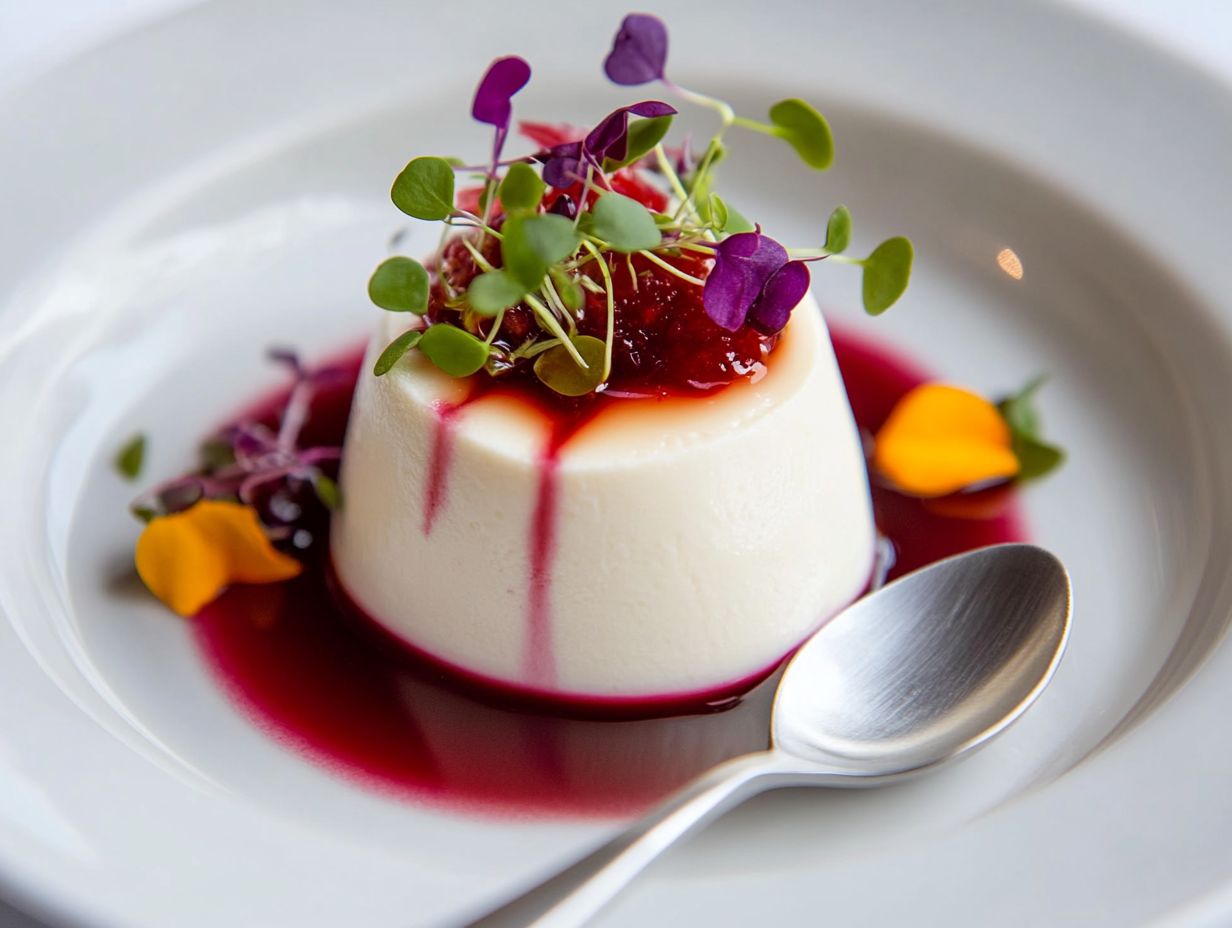
You can sprinkle microgreens on top of your finished desserts as a garnish, blend them into drinks, or use them as a main ingredient in your dessert creations, like pestos and sauces.
3. Which types of microgreens work best in desserts?
Some popular microgreens to use in desserts include sunflower, pea shoots, and micro basil. You can also use chives or spinach microgreens for a unique twist or as toppings.
4. Can I grow my own microgreens for desserts?
Absolutely! Growing your own microgreens is a fun and easy way to have a fresh supply for all your culinary creations. Many people enjoy using them in tacos, burritos, or vegetable wraps.
5. Can I safely enjoy microgreens in my desserts?
Yes, microgreens are safe to eat in desserts as long as they are grown and handled properly. Always wash them thoroughly before using and make sure to purchase from a reputable source, especially for salads or toppings.
6. What are the health benefits of adding microgreens to desserts?
Microgreens are rich in vitamins, minerals, and antioxidants, making them a nutritious addition to any dessert, including healthy snacks and various recipes like sushi and fish dishes.
Why wait? Start your microgreens garden today and enjoy fresh flavors in your meals!

